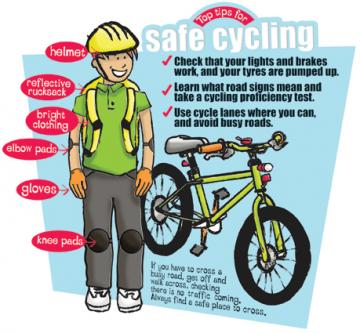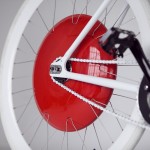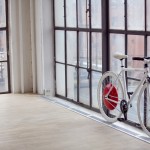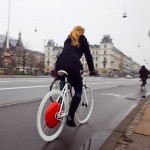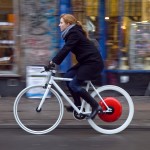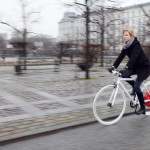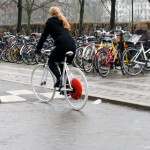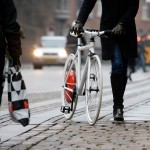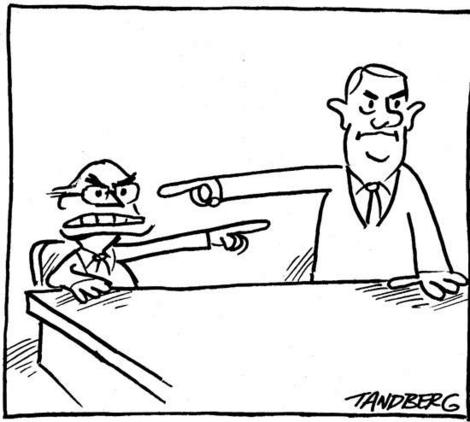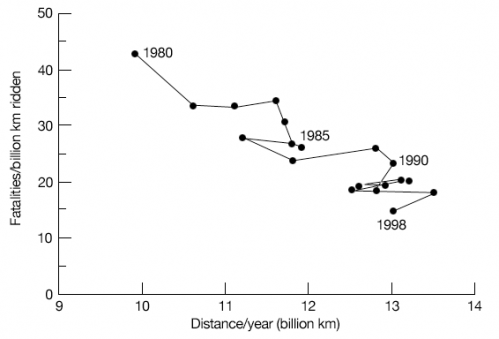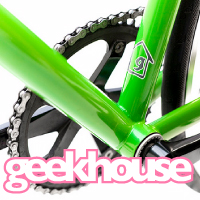The Latest From BostonBiker.org
News, Events, Updates
Science And Cycling: The Pothole
Written by Boston Biker on Feb 10As you probably have noticed there seem to be a lot of new potholes around. Potholes might be the wrong term, is there a word that means “giant wheel swallowing death traps filled with ice cold salt water?” Pothells?
I nearly ended up like the guy above yesterday as a brand new pit had sprung forth on a street that had been bereft of them the day before. I was able to swerve and avoid the front wheel and bunny hop the back wheel over it, in the most ungraceful way possible.
So where do all these monsters come from? And why do they seem to appear so suddenly? That my friend is a job for science!
To understand potholes you have to understand water. Most things shrink when they get cold, and expand when they get warm. Water is one of the few things that actually gets bigger as it gets colder. The reason for this is the way in which water molecules link up as they become ice.
The next thing you have to understand is that the road surface is not a single sold object. It feels pretty solid when you fall off your bike onto it, but its actually very porous. Black top is made of gravel and tar, concrete is comprised of gravel and cement. The road has lots of little spaces for water to soak into.
The road and everything else that is embedded into it, (utility covers, grates, train tracks, etc), shrink and expand as they heat and cool. Just to make it complicated they all expand and shrink at different rates, opening even more holes for water to soak into. Even things like white painted lines on the road can affect the rate at which things heat up and cool down.
The water soaks into tiny cracks in the road during the day when it is above freezing, at night when it cools down the water expands and pops open that hole a little more. The next day MORE water gets in there, when it freezes that hole gets bigger, repeat till your front wheel will fit into the hole. Metal objects only make this process faster, which is why you often see the worst potholes around utility hole covers and grates.
Just for good measure add a bunch of heavy vehicles driving over the surface and the smooth city streets are soon infested with a legion of evil potholes.
The recent spat of warm weather we had combined with the recent spat of extremely cold weather has caused a bumper crop of potholes. So many in fact that it seems every street now has one. Be vigilant riders, for a dark evil lurks below your wheels. Be sure to glance down once in a while to make sure a road once loyal is trustworthy still!
Tags: evil, potholes, science
Posted in education, fun | 3 Comments »
Cycling Is Good For You, Safe, And Good For Everyone Else, So Says Science
Written by Boston Biker on Sep 29If the traffic crashes and fatalities being at record low levels was not enough to convince you that cycling is safe, check out this new study about the health risks (or lack thereof) regarding cycling.
Its written in science language but I have made bold the area that you should be concerned about, read the whole thing here.
Although from a societal point of view a modal shift from car to bicycle may have beneficial health effects due to decreased air pollution emissions, decreased greenhouse gas emissions, and increased levels of physical activity, shifts in individual adverse health effects such as higher exposure to air pollution and risk of a traffic accident may prevail.
Objective: We describe whether the health benefits from the increased physical activity of a modal shift for urban commutes outweigh the health risks.
Data sources and extraction: We have summarized the literature for air pollution, traffic accidents, and physical activity using systematic reviews supplemented with recent key studies.
Data synthesis: We quantified the impact on all-cause mortality when 500,000 people would make a transition from car to bicycle for short trips on a daily basis in the Netherlands. We have expressed mortality impacts in life-years gained or lost, using life table calculations. For individuals who shift from car to bicycle, we estimated that beneficial effects of increased physical activity are substantially larger (3–14 months gained) than the potential mortality effect of increased inhaled air pollution doses (0.8–40 days lost) and the increase in traffic accidents (5–9 days lost). Societal benefits are even larger because of a modest reduction in air pollution and greenhouse gas emissions and traffic accidents.
Conclusions: On average, the estimated health benefits of cycling were substantially larger than the risks relative to car driving for individuals shifting their mode of transport.
From a societal point of view, shifting from cars to other forms of transportation, such as bicycles, may have beneficial health effects due to decreased air pollution emissions, decreased greenhouse gas emissions, and increased levels of physical activity. However, increased use of bicycles may increase both personal exposure to air pollutants and the risk of traffic accidents. De Hartog et al. (p. 1109) reviewed the literature for air pollution, traffic accidents, and physical activity and estimated the impact on all-cause mortality if 500,000 people shifted from cars to bicycles for short trips on a daily basis. The authors expressed the impact on mortality in life-years gained or lost using life table calculations. For individuals shifting from cars to bicycles, the authors estimated that beneficial effects of increased physical activity would be substantially larger than potential mortality due to increased air pollution exposure and traffic accidents. Societal benefits of cycling were even larger due to a modest reduction in air pollution and greenhouse gas emissions and traffic accidents. The authors conclude that the health benefits of cycling are on average nine times greater than the risks associated with driving a car.
Or to summarize, yes you are going to be putting yourself at a little risk due to pollution while riding your bike, but its better for you to suck down a little exhaust and be active than sit around in your car and suck down exhaust. Plus you are making life better for everyone else as well.
The study goes on to consider accidents, and other dangers associated with cycling, and finds overall that you are much better off cycling than not.
You can read more here.
Tags: cycling is good for you, go ride your bike, science, study
Posted in advocacy, education, news | 3 Comments »
A Red Light Runner, Tries Stopping For A Week
Written by Boston Biker on May 02100 psi, the very well written blog, tried a little experiment. What would happen if you stopped at every red light for a week. I enjoyed the read, here is a little taste.

For the past five days, I conducted a non-scientific experiment of ALWAWYS stopping at EVERY red light and waiting for the green light on my daily commute.
And I non-scientifically concluded: it didn’t suck.
…
On the whole, waiting for reds made for a less stressful commute. I didn’t have to constantly scan the intersection while making a breakaway, nor maneuver through waiting cars to get to the front of the traffic line to get that two-second window of all reds at Cleveland Circle and get a jump to make a left turn, for example. Also, I took the lane more often while waiting, as opposed to snaking over to the right or splitting lanes where motorist can see me less than they already do. And I didn’t make an illegal turn at Beacon and Harvard, which I normally do. How about that?
And waiting at reds allowed me to catch my breath or take a drink of water, and for some good old fashion girl watching.
Read the rest here, and let 100 psi know what you think in the comments on his (I think its a he, my apologies if not) blog.
Tags: 100 psi, red lights, science, stopping
Posted in advocacy, bostonbiker | 2 Comments »
MIT Unveils The Copenhagen Wheel
Written by Boston Biker on Dec 15So my first impression was…what? Then I was sorta, hmmm. Now I am kinda What? Hmmm….
I am not really sure how I feel about MIT’s new Copenhagen Wheel part of me is really excited about how this could bring more people into cycling, but another part of me is kind of turned off by all the gizmo’s and wizbangs. One of the reasons why I cycle is because it is simple. This is very complicated but wrapped up in a simple shell. If it all works like they say it might be a great way to get people who would otherwise not cycle (because they are lazy, or not physically fit enough) cycling. It also allows you to collect all sorts of environmental data about the routes you cycle.
The best part of the site in my opinion is the kinds of things cities could use all this data for:
A BIGGER CONTRIBUTION
You can also make a bigger contribution through your daily commute. And share your data, anonymously, with your city. When many cyclists donate the information their wheel is collecting, your city gains access to a new scale of fine-grained environmental information. Through this, your city can: Cross analyze different types of environmental data on a scale that has never before been achieved before. Build a more detailed understanding of the impact of transportation, on a city infrastructure Or study dynamic phenomena like urban heat islands. Ultimately, this type of crowd sourcing can influence how your city allocates its resources, how it responds to environmental conditions in real-time or how it structures and implements environmental and transportation policies.
Here is there press release and quotes from their website:
MIT’S BIG WHEEL IN COPENHAGEN
New bicycle wheel not only boosts power using Formula One inspired technology, but also can keep track of fitness, friends, smog and traffic – helping Copenhagen become the first carbon neutral capital by 2025 It looks like an ordinary bicycle wheel with an oversized center. But packed inside the sleek, bright red hub is a veritable Swiss army knife’s worth of electronic gadgets and novel functions.The Copenhagen Wheel, designed by researchers at MIT’s Senseable City Lab, will be presented at the Copenhagen Conference on Climate Change on December 15, 2009 before heads of state and mayors form all over the world. It can store energy every time the rider brakes and then give that power back to provide a boost when going uphill or to add a burst of speed in traffic. “The wheel uses a technology similar to the KERS (Kinetic Energy Recovery System), which has radically changed Formula One racing over the past couple of years.
When you brake, your kinetic energy is recuperated by an electric motor and then stored by batteries within the wheel, so that you can have it back to you when you need it.” – explains professor Carlo Ratti, Director of the MIT Senseable City Lab. “The bike wheel contains all you need so that no sensors or additional electronics need to be added to the frame and an existing bike can be retrofitted with the blink of en eye. In a sense, you drive by foot: when you pedal forward the motor supplements your torque; when you pedal backwards to brake, the motor starts regenerating electric energy while reducing your speed.”
The first goal of the Copenhagen Wheel is to promote cycling by extending the range of distance people can cover and by making the whole riding experience smoother so that even steep up-hills are not longer a barrier to comfortable cycling. Accordig to Ritt Bjerregaard, Lord Mayor of Copenhagen, “our city’s ambition is that 50% of the citizens will take their bike to work or school every day. So for us, this project is part of the answer to how can we make using a bike even more attractive.”
But there are also a variety of extra functions hidden within the hub of the Copenhagen Wheel. By using a series of sensors and a Bluetooth connection to the user’s iPhone, which can be mounted on the handlebars, the wheel can monitor the bicycle’s speed, direction and distance traveled, as well as collect data on air pollution and even the proximity of the rider’s friends. “One of the applications that we have discussed with the City of Copenhagen is that of an incentive scheme whereby citizens collect Green Miles – something similar to frequent flyer miles, but good for the environment,” comments Christine Outram, who led the team of researchers at MIT.The project aims to create a platform for individual behavioral change. “The Copenhagen Wheel is part of a more general trend: that of inserting intelligence in our everyday objects and of creating a smart support infrastructure around ourselves for everyday life,” comments Assaf Biderman, Associate Director of the Senseable City Lab. “The Wheel also has a smart lock: if somebody tries to steal it, it goes into a mode where the brake regenerates the maximum amount of power, and sends you a text message. So in the worst case scenario the thief will have charged your batteries before you get back your bike.” The initial prototypes of the Copenhagen Wheel were developed along with company Ducati Energia and the Italian Ministry of the Environment. It is expected that the wheel will go into production next year, with a tag price competitive with that of a standard electric bike. According to Claus Juhl, CEO of Copenhagen, the city might place the first order and use bicycles retrofitted with the Copenhagen Wheel as a substitution for city employee cars as part of the city’s goal to become the world’s first carbon-neutral capital by 2025.
The Copenhagen Wheel team at MIT is composed of Christine Outram, Project Leader, Rex Britter, Andrea Cassi, Xiaoji Chen, Jennifer Dunnam, Paula Echeverri, Myshkin Ingawale, Ari Kardasis, E Roon Kang, Sey Min, Assaf Biderman and Carlo Ratti. The project was developed for the City of Copenhagen in cooperation with Ducati Energia and with the support of the Italian Ministry for the Environment.
Patti Richards Director, Media Relations MIT News Office Massachusetts Institute of Technology
77 Massachusetts Ave., Room 11-400
Cambridge, MA 02139
tel: 617.253.8923
main:617.253.2700
[email protected]QUOTES BY PROFESSOR CARLO RATTI,
DIRECTOR SENSEABLE CITY LAB– “It uses a technology similar to the KERS (Kinetic Energy Recovery System), which has revolutionized
Formula One racing over the past couple of years. When you brake, your kinetic energy is recuperated
by an electric motor and then stored by batteries within the wheel, so you can get it back
when you need it.”– “The Wheel is a self contained unit. It can be plugged into any bike without requiring additional
electronics or wires. It is fully controlled by your feet: when you pedal forward, the motor supplements
your torque; when you pedal backwards to brake, the motor starts regenerating electric energy while
reducing your speed.”– “Over the past few years we have seen a kind of ‘biking renaissance,’ which started in Copenhagen
and is now transforming the urban experience in many cities from Paris to Barcelona or Montreal.
We could also call it a ‘Biking 2.0’ revolution, whereby cheap electronics allow us to augment bikes
and convert them into a more flexible, on-demand system.”– “The initial prototypes of the Copenhagen Wheel were expensive, but after production streamlining,
we calculate that the price will be competitive with that of a standard electric bike.”– “The Copenhagen Wheel is part of a more general trend of inserting intelligence into our everyday
objects to create a smart, supporting infrastructure around ourselves.”
QUOTES BY ASSAF BIDERMAN,
ASSOCIATE DIRECTOR OF THE SENSSEABLE CITY LAB– “Our goal with the Copenhagen Wheel is to promote cycling by expanding the range of distance
people can cover and by making the riding experience smoother. When long distance and steep hills
are no longer barriers to comfortable cycling, many cities can become more bicycle-friendly.– “The bike wheel is an extension of your personal mobile device.
Controlled through your smart phone, the wheel recognizes you as you approach. While you ride, you
can switch gears and motor modes using your phone, and receive real-time alerts automatically”.– “The Wheel also has a smart security system: if someone rides away with it, the Wheel goes into a
mode where the brake regenerates the maximum amount of power and sends you a text message
with its location. So in the worst case, the thief will have fully charged your batteries before you get
back your bike.”– “As bikers collect and share air quality data, cycling becomes more than a clean mode of transport. It
opens yet another door for citizens to participate in governance and in the maintenance of public
resources”.– “Bicycles are very efficient machines. Rather than reinventing them, we’re introducing a simple
technological enhancement that allows any bike to become a smart and responsive hybrid”
QUOTES BY CHRISTINE OUTRAM,
COPENHAGEN WHEEL PROJECT LEADER– “One of the applications we developed for the city is a Green Mile program, which is similar to a
frequent flyer program, but good for the environment.”– “It opens the door for individuals to participate in plans to reduce emissions, such as carbon cap and
trade, which have so far been offered mostly to large organizations.”
QUOTES BY CORRADO CLINI,
COPENHAGEN WHEEL PROJECT– “In 2009, The Italian Ministry for the Environment put aside 12 million euros for supporting the
dissemination of cycling in cities. The Copenhagen Wheel fits with our vision and represents an
exciting step towards sustainable urban transportation.”
Here are some images of it in action. Sleek looking design, but I worry about the spokes…they look a bit…fragile.
Tags: Copenhagen wheel, e-bike, MIT, science, technology
Posted in Mechanical, news, video | 10 Comments »
Who’s To Blame?
Written by Boston Biker on Aug 31Most bike crashes do not involve car-bike interaction. Most bike crashes (90%) are caused by bicyclists crashing into stationary objects (parked cars, pot holes, curbs, etc), and other non-car related things (other cyclists, pedestrians, animals). The vast majority of these crashes go unreported, because they are either minor injuries, or they simply have no one else to hold legally accountable so they don’t end up with a police report.
A new study from Toronto show’s that of the 10% of crashes that do involve motorist-cyclist interaction a whopping 90% are because of motorists. (the following was stolen without permission from this amazing website, please forgive me!)
What are the Dangers in Terms of Cycling Safety?
- Accident rates per kilometer are 26 to 48 times higher for bikes than for automobiles (13).
- Nearly 44,000 cyclists have died in traffic crashes in the United States since 1932 (the first year in which estimates of cyclist fatalities were recorded) (14).
- U.S. cyclists are three times more likely to be killed than German cyclists and six times more than Dutch cyclists, whether compared per-trip or per-distance traveled (7).
- According the British Medical Journal, the most important deterrent to riding bikes expressed by non-cyclists is fear of motor traffic (15).
- While motorists often accuse cyclists of being the cause of bike-car accidents, a Toronto analysis of 2572 police collision reports (Table 1) demonstrates that this is actually not the case. The most common type of crash in this study involved a motorist entering an intersection controlled by a stop sign or red light, and either failing to stop properly, or proceeding before it was safe to do so. The second most common crash type involved a motorist overtaking unsafely. The third most common type of crash is a motorist opening a door onto an oncoming cyclist. In fact, cyclists are the cause of less than 10% of bike-car accidents in this study (1).
Table 1: Most Frequent Crash Types
Crash Type Number of Cases Relative Frequency Drive Out at Controlled Intersection 284 12.20% Motorist Overtakign 277 11.90% Motorist Opens Door in front of Bicyclist 276 11.90% Motorist Left Turn – Facing Bicyclist 248 10.70% Motorist Right Turn – Other 224 9.60% Motorist Right Turn at Red Light 179 7.70% Drive Out from Lane or Driveway 179 7.70% Ride Out At Controlled Intersection 73 3.10% Wrong Way Bicyclist 59 2.50% Ride Out At Mid-block 51 2.20% From: Tomlinson, David. Conflicts Between Cyclists and Motorists in Toronto, Canada (1).
- Data from Canada suggests that provinces that have invested the most in cycling tend to have the highest rates of cycling and also the lowest rates cycling mortality. Quebec has invested more than any other province on cycling (5). For the period 1987 to 2000, the total number of bicycles in Quebec more than doubled, and the number of regular cyclists increased by 50%, while cycling fatalities fell by 42%, serious injuries fell by 56%, and minor injuries fell by 38% (5).
- Data from Europe (Figures 1and 2) also suggests that counties that have invested the most in cycling tend to have the highest rates of cycling and also the lowest rates cycling mortality (6).
Figure 1: Cycling risk versus cycling intensity in European countries
Risk of cycling tends to be lowest in the countries with the most cycling (6)
Figure 2: Bicycling in Netherlands 1980-1998
A 30% increase in cycle traffic is associated with a two-third reduction in risk, e.g. a decrease of the total number of fatal cycling accidents (6).
As levels of pedestrian and bicyclist activity rise their per capita risk falls. Drivers adapt their behavior in the presence of increased cycling and walking (17).
I highly suggest you go read the rest of this website, as it is very well put together and very convincing.
Tags: bike crashes, blame, science, survey, toronto
Posted in advocacy | 5 Comments »
The Word On The Street
 Here is what people are saying
Here is what people are saying
- Where bicycles are prohibited in Massachusetts August 16, 2023TweetThe main issue you will confront if you get into a dispute with police over bicycle prohibitions is whether the prohibition is supported by law. Often it is not. Example: the ramp from Commonwealth Avenue to Route 128 northbound and … Continue reading →jsallen
- Where bicycles are prohibited in Massachusetts August 16, 2023TweetThe main issue you will confront if you get into a dispute with police over bicycle prohibitions is whether the prohibition is supported by law. Often it is not. Example: the ramp from Commonwealth Avenue to Route 128 northbound and … Continue reading →jsallen
- It’s Finally Happening! 5th Annual Hot Cocoa Ride Feb 12! February 8, 2022... Continue reading →commonwheels
- It’s Finally Happening! 5th Annual Hot Cocoa Ride Feb 12! February 8, 2022... Continue reading →commonwheels
- Hello world! June 9, 2021Welcome to WordPress. This is your first post. Edit or delete it, then start writing! Continue reading →thecommunityspoke
- Run The Jewels Lead Free Pewter Hand Carved And Cast Pin Set January 3, 2021Made these lovely RTJ fist and gun pin set. Hand carved in wax, and then cast in lead free pewter. Because these are made by hand you can do fun things like add an extra small pin so that they sit just so (also means they have “customized” brass back plates to accommodate the extra […]Boston Biker
- My Work In The Wild: Feather Head Badge With Chris King Headset January 3, 2021One of my customers sent me this amazing picture of my feather badge installed on their (awesome!) bike. Check out Manofmultnomah (here and here), apparently Chris King took some interest in it as well. Want one of your own? Buy it here, or here... Continue reading →Boston Biker
- Boston’s Invitation to Improve Biking in Boston: Draw on Some Maps! December 14, 2020TweetSometimes, the best way to gather ideas and feedback is to let people draw on some maps. Last night, at the Bike Network Open House, pedallovers unveiled a draft for their upcoming plans for a more connected biking network infrastructure … Continue reading →greg
- Boston’s Invitation to Improve Biking in Boston: Draw on Some Maps! December 14, 2020TweetSometimes, the best way to gather ideas and feedback is to let people draw on some maps. Last night, at the Bike Network Open House, pedallovers unveiled a draft for their upcoming plans for a more connected biking network infrastructure … Continue reading →greg
- Boston’s Invitation to Improve Biking in Boston: Draw on Some Maps! December 14, 2020TweetSometimes, the best way to gather ideas and feedback is to let people draw on some maps. Last night, at the Bike Network Open House, pedallovers unveiled a draft for their upcoming plans for a more connected biking network infrastructure … Continue reading →greg




 Add to Reddit.
Add to Reddit. 